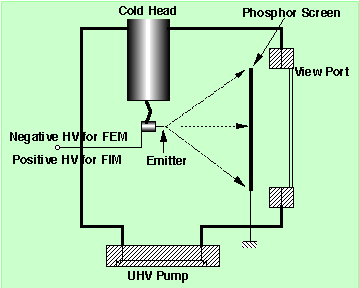field-emission microscope

Schematic diagram of a field-emission microscope.
A field-emission microscope is a lower-resolution relative of the field-ion microscope, in which the image is produced by electrons emitted by the tip itself when negatively charged. In its simplest form, the field-emission microscope (FEM) consists of a sharp needle emitter and a fluorescent screen. When a negative field is applied to the emitter, electrons are given off from its surface in the direction of the screen. The image contrast appears due to differences in current densities of electrons, which result from the differences in work functions and electric field on the emitter surface.
The field emission microscope was invented by Erwin Müller in 1936. It was one of the first surface analysis instruments to approach near-atomic resolution.


